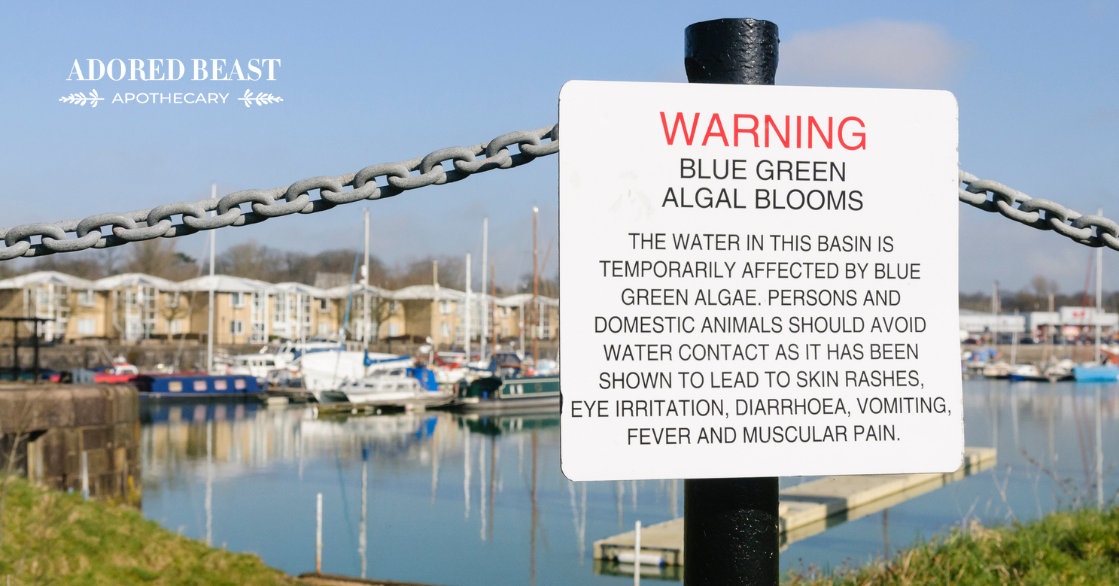Just as it has been for the last few years, as summer ramps up, we’re seeing more and more reports of blue-green algae poisoning in dogs in the news. Blue-green algae is a toxic threat lurking in many bodies of water. This is a serious issue, one that many pet parents are either facing or are concerned about all across North America. Countless cities/towns/counties have posted alerts or even completely closed lakes due to contamination!
Now we’re reading reports of a new threat – it’s called benthic algae, and it typically grows on rocks. It’s a type of cyanobacteria, the scientific name for blue-green algae, that forms mats (clumps resembling vegetation) on the bottom of lakes, rivers, and ponds. Benthic mats can appear as floating mats or “carpets” on the water surface or be attached to the bottom of the water body.
As a pet parent, ensuring your dog’s safety during outdoor activities is paramount. Understanding what it is, recognizing the potential dangers, and knowing how to protect your dog can be lifesaving. That’s what this blog is all about.
What is Blue-Green Algae?
Blue-green algae, also known as cyanobacteria, are microscopic organisms found in freshwater bodies such as ponds, lakes, and streams. These organisms thrive in warm, nutrient-rich waters and can multiply rapidly, forming blooms that look like green, blue-green, or brown scum on the water’s surface. Despite their name, blue-green algae aren’t true algae but bacteria capable of producing harmful toxins.
This bacteria can bloom at any time of year, but changes in water temperature or flow, PH fluctuations, and run-offs from lawn and farm fertilizers are causing cyanobacteria to multiply faster, according to the United States Environmental Agency (EPA). August is the month when these blooms are most prevalent, but we’ve seen plenty of reports already.
Blue-green algae pose significant risks to dogs because they can produce several types of toxins, including:
- Hepatotoxins: Affect the liver, leading to severe liver damage or failure.
- Neurotoxins: Impact the nervous system, causing muscle tremors, seizures, or even respiratory paralysis.
- Dermatotoxins: Can cause skin irritation and allergic reactions.
Dogs are particularly vulnerable because they are more likely to drink or play in contaminated water. Unfortunately, blue-green algae poisoning is a serious danger. Cyanobacteria is highly toxic to dogs – they can become ill at very low levels of exposure or even die within hours.
**NOTE: Blue-green algae is also toxic to humans, and can cause organ failure or other issues. It’s best for everyone to stay out of contaminated bodies of water.
Signs of Blue-Green Algae Poisoning in Dogs
Symptoms of blue-green algae poisoning in dogs can appear within minutes to hours after exposure and include:
- Vomiting and diarrhea
- Drooling
- Weakness or lethargy
- Difficulty breathing
- Muscle tremors or seizures
- Jaundice (yellowing of the skin and eyes)
- Disorientation or staggering
🚨 If you suspect your dog has been exposed to blue-green algae, it’s crucial to seek veterinary care immediately. Rapid treatment can significantly improve the chances of recovery.
How to Avoid Blue-Green Algae
- Stay Informed: Check local advisories and warnings about algae blooms before heading to water bodies with your dog. Many local health departments and environmental agencies provide updates on water safety. If there is any kind of alert – seriously, even a mild one – stay away from the water.
- Visual Inspection: Avoid water that looks discoloured, has a foul odour, or has visible scum or foam on the surface. You might notice suspicious blue-green material that looks like scum, foam, or paint floating mat-like on the water’s surface. Sometimes dead fish float near the shore where there are toxic algae blooms. If you see any signs of an algae bloom, keep your dog away.
- Keep Your Dog Leashed: When near bodies of water, keep your dog on a leash to prevent them from jumping in and potentially ingesting contaminated water.
- Provide Fresh Water: Always bring fresh water for your dog to drink, reducing the temptation for them to drink from natural water sources.
Immediate Actions if Exposure Occurs
- Rinse Off Immediately: If your dog has been in contact with water that may contain blue-green algae, rinse them off with clean, fresh water as soon as possible to remove any toxins from their fur and skin.
- Monitor for Symptoms: Keep a close eye on your dog for any signs of poisoning, even if they only had brief contact with the water.
- Seek Veterinary Care: If you notice any symptoms or suspect your dog has ingested contaminated water, contact your veterinarian immediately. Inform them about the potential exposure to blue-green algae so they can provide appropriate treatment.
As the number of news reports of blue-green algae poisoning in dogs grows, we’re reminded that this is a very real danger. By being aware of the dangers, paying attention to any and all alerts, and taking preventive steps, you can ensure your outdoor adventures with your dog remain safe and enjoyable.












